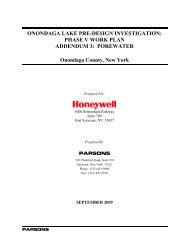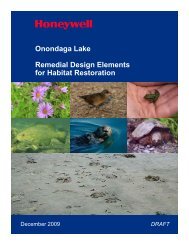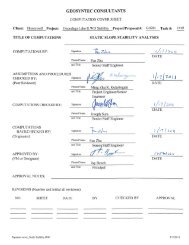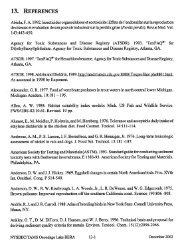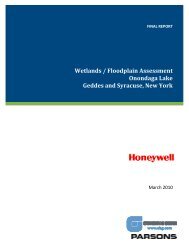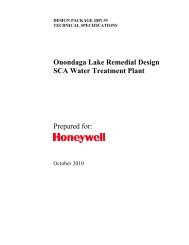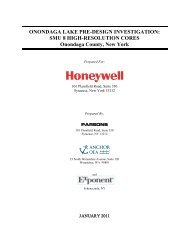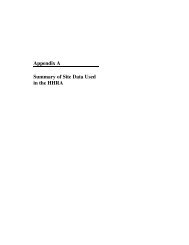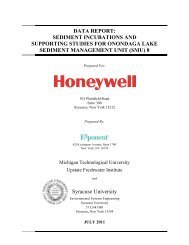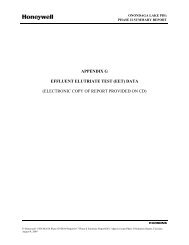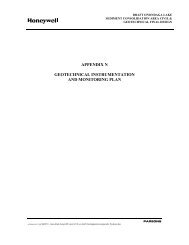Phase 1B Underwater Archaeological Report for the Onondaga ...
Phase 1B Underwater Archaeological Report for the Onondaga ...
Phase 1B Underwater Archaeological Report for the Onondaga ...
Create successful ePaper yourself
Turn your PDF publications into a flip-book with our unique Google optimized e-Paper software.
FINAL<br />
<strong>Phase</strong> IB <strong>Underwater</strong> <strong>Archaeological</strong> Resources <strong>Report</strong> <strong>for</strong> <strong>Onondaga</strong> Lake Superfund Site<br />
RECOMMEND REDUCE ADVERSE EFFECTS AND DATA RECOVERY<br />
Syracuse Maritime Historic District<br />
The Syracuse Maritime Historic District is a proposed National Register district comprised of <strong>the</strong> remains<br />
of seven wooden watercraft, six areas of marine infrastructure, and three rock mounds. The 16<br />
contributing properties are listed in <strong>the</strong> table below.<br />
Table 3. Contributing Properties to <strong>the</strong> Syracuse Maritime Historic District<br />
Wooden Watercraft Marine Infrastructure Rock Mounds<br />
A3 (Barge) A1/A2 (Salina Pier) A34 (Rock Mound)<br />
A4-1 (Dump Scow) A7 (Piling Clumps) A75 (Rock Pile)<br />
A4-2 (Dump Scow) A38 (Iron Pier Marine Infrastructure) A76 (Rock Pile)<br />
A12 (Derrick Lighter Spud Barge) A45 (Concrete Breakwater)<br />
A35 (Unknown Boat Type)<br />
A72 (Pilings)<br />
A53 (Canal Boat)<br />
A73 (Bulkhead)<br />
A55 (Canal Scow)<br />
The District is contained in 58 acres (23.9 hectares) of <strong>Onondaga</strong> Lake bottom lands. The boundaries are<br />
delineated by <strong>the</strong> lake shoreline to <strong>the</strong> east and Salina Pier remnants to <strong>the</strong> north. The sou<strong>the</strong>rn and<br />
western boundaries are lines drawn to encompass <strong>the</strong> extent of <strong>the</strong> contributing properties (Figure 36).<br />
The 2010 remote sensing and dive verification ef<strong>for</strong>ts in <strong>the</strong> Syracuse Maritime Historic District located<br />
eleven archaeological sites. Upon completion of <strong>the</strong> 2010 field campaign <strong>the</strong>re was concern that given<br />
<strong>the</strong> density of sites, <strong>the</strong>re was <strong>the</strong> possibility that additional undiscovered sites could still remain within<br />
<strong>the</strong> District. There<strong>for</strong>e, a methodological approach designed specifically <strong>for</strong> <strong>the</strong> District, comprising a reexamination<br />
and dive verification of magnetic anomalies, and systematic diver survey in waters within<br />
200ft (61m) of <strong>the</strong> shoreline, was executed in 2011. Twenty two additional magnetic targets were<br />
identified from <strong>the</strong> extant geophysical data. None of <strong>the</strong>se targets was identified as an archaeological<br />
site, 13 remain unidentified and nine were determined to be modern debris. The systematic shallow<br />
water survey located four previously unknown archaeological sites.<br />
The Syracuse Maritime Historic District’s development can be tracked on mid-twentieth century<br />
navigational charts. Charts from <strong>the</strong> U.S. Lake Survey Office from 1915, 1926, 1932 and 1937 show no<br />
wrecks or derelict vessels in this area. 124 However, <strong>the</strong> 1942 edition shows derelict vessels in <strong>the</strong><br />
approximate locations of A3, A12, A4-1 and A4-2 (Figure 37). 125<br />
The <strong>for</strong>mation of <strong>the</strong> Syracuse Maritime Historic District is linked to <strong>the</strong> development of <strong>the</strong> Syracuse<br />
Inner Harbor and <strong>the</strong> New York State Barge Canal system. Prior to <strong>the</strong> establishment of <strong>the</strong> Barge Canal,<br />
<strong>the</strong> Oswego Canal paralleled <strong>the</strong> nor<strong>the</strong>astern lakeshore with access to <strong>Onondaga</strong> Lake provided from<br />
<strong>the</strong> canal’s “Mud Lock” on <strong>the</strong> Seneca River. From <strong>the</strong> river, <strong>the</strong> <strong>Onondaga</strong> Lake Outlet provided access<br />
to <strong>the</strong> lake. The 1915 barge canal expansion abandoned <strong>the</strong> canal adjacent to <strong>the</strong> lake in favor of a<br />
navigable channel through Oneida Lake and <strong>the</strong> Seneca River. With <strong>the</strong> re-routing, access to Syracuse<br />
was provided through <strong>the</strong> Seneca River into <strong>Onondaga</strong> Lake. A new inner harbor into Syracuse was<br />
constructed with an outlet into <strong>the</strong> sou<strong>the</strong>astern corner of <strong>Onondaga</strong> Lake. With increased navigation<br />
on <strong>Onondaga</strong> Lake it became a convenient location to dispose of unwanted vessels. The State’s Canal<br />
Laws had specific provisions designed to prevent obstructions to navigation in <strong>the</strong> canal. A person who<br />
obstructed canal navigation through any number of actions including “sinking a vessel” was fined a sum<br />
54



